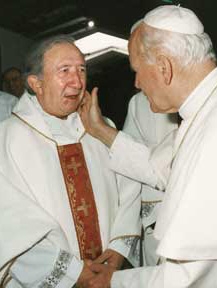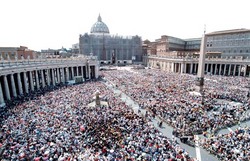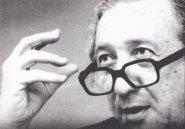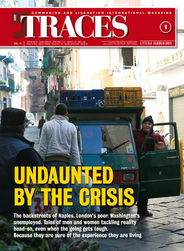 On this date in 1982, Pope John Paul II officially recognized (approved) Communion and Liberation as an authentic charism in the Church. The recognition of this fact for the Church means the work of Father Luigi Giussani and so many others was really born of the Holy Spirit. What follows are few items about the movement which come from the CL archives.
On this date in 1982, Pope John Paul II officially recognized (approved) Communion and Liberation as an authentic charism in the Church. The recognition of this fact for the Church means the work of Father Luigi Giussani and so many others was really born of the Holy Spirit. What follows are few items about the movement which come from the CL archives.
The Fraternity of Communion and Liberation
This is the eminent group among those born from the movement, whose origins and aims it shares. It was recognized as a Lay Association of Pontifical Right on
This recognition from the Pontifical Council for the Laity amounted to de facto approval of the educational experience of CL.
The first "Fraternity" groups were formed around the mid-1970s at the initiative of some former university students who wanted to go more deeply into what it means to belong to the Church, also within the conditions of adult life and the responsibilities it brings, in communion with others.
 Today the Fraternity's groups host 50,000 people who have made the decision to commit themselves to a way of life that supports the path to holiness, acknowledged as the true aim of existence. The life of the Fraternity normally takes place through the free formation of groups who consider that commitment to be the reason for their friendship and sharing.
Today the Fraternity's groups host 50,000 people who have made the decision to commit themselves to a way of life that supports the path to holiness, acknowledged as the true aim of existence. The life of the Fraternity normally takes place through the free formation of groups who consider that commitment to be the reason for their friendship and sharing.
Belonging to the Fraternity calls for a minimal rule of personal ascesis, daily moments of prayer, participation in encounters of spiritual formation including an annual retreat, and commitment to the support, financial and otherwise, of the charitable, missionary, and cultural initiatives promoted or sustained by the Fraternity.
Recent years have witnessed also in Italy and abroad the rise of Fraternity groups formed by diocesan priests (the first of these took the name of Studium Christi) who in this way intend to help each other pursue more deeply their vocation and the accomplishment of their mission.
On the occasion of the twentieth anniversary of the pontifical recognition of the Fraternity of Communion and Liberation, John Paul II writes Fr Giussani a long autograph letter.
Subsequently, Fr Giussani writes all the members of the Fraternity to call attention to the great value of the Pope's letter and to the importance of the indications conveyed.
What is Communion & Liberation?
Communion and Liberation is an ecclesial movement whose purpose is the education to Christian maturity of its adherents and collaboration in the mission of the Church in all the spheres of contemporary life.
 It began in
It began in
There is no type of membership card, but only the free participation of persons. The basic instrument for the formation of adherents is weekly catechesis, called "School of Community."
 The official magazine of the Movement is the international monthly, Traces - Litterae Communionis
The official magazine of the Movement is the international monthly, Traces - Litterae Communionis
*email Kim for a subscription ($30.00 per year): traces@clhac.com
This Traces article is worth your review: A New Movement: A Story of a Beginning


Leave a comment